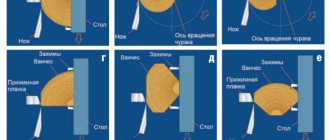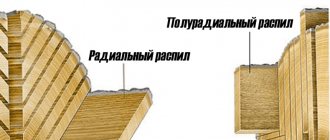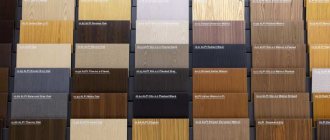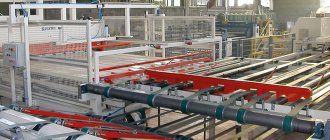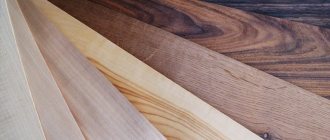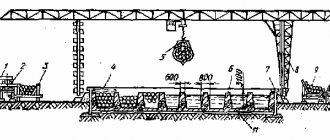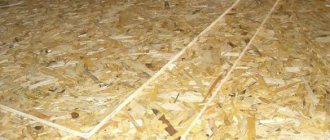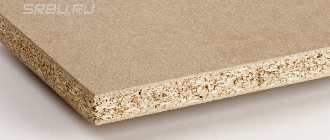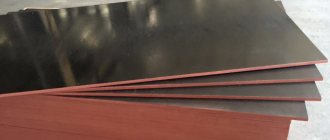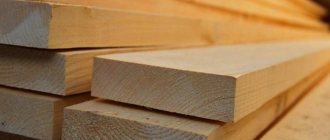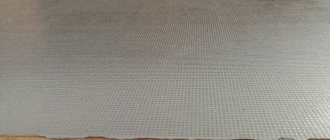Veneer is a thin layer of wood with a textured pattern produced by peeling, planing, or sawing logs.
The word “veneer” comes from the German “spon” , which means “sliver”. In Germany, another word is now used to denote veneer - “furnier”, similar to the Russian “plywood”, which has German and French roots. Veneer is used for decorative finishing of furniture and other wood products.
Sliced veneer first produced in the USA at the beginning of the 19th century on a machine about 1.5 m wide. In 1870, sliced veneer began to be produced in France. And in 1901 in Italy, the Cremona family mastered the production of planed veneer on the first horizontal planer.
In the production of sliced veneer, a running knife planes a pre-fixed log (while in the production of peeled veneer the log rotates around a stationary knife). In this way, veneer sheets with a thickness of 0.2 to 3 mm are obtained, which are folded into bundles (“knoli”). A certain number of packs form a package (“pallet”).
The dimensions and texture (stripe or flame) of veneer sheets depend on the wood used, the characteristic features of the log and its cutting system. Each pack contains veneer sheets, usually of the same size.
The use of thin layers of sliced veneer gave a new impetus to the development of the furniture industry. It became possible to produce lighter and more affordable furniture by dramatically reducing the amount of wood used to make it. An important result of the use of veneer was the production of furniture and interior items from wood species that were considered unsuitable for use in solid wood due to their uneven sizes (for example, the beautiful and popular “root” and exotic woods). And the technology of veneering or veneering (gluing veneer onto a stable base - a tambourate panel, MDF, chipboard, plywood, etc.) made it possible to produce finished products from materials that are not subject to deformation and cracks characteristic of solid wood.
In the mass production of furniture, the use of sliced veneer is an ideal choice for solving issues related to practicality, ease of transportation, and reducing wood costs for furniture production. After all, from 1 m² of solid wood 3 cm thick, about 50 m² of veneer is obtained!
Developments in the use of veneer led to the emergence of "full-thickness dyed veneer" . This made it possible to design multi-layer veneers and solid wood, reducing material consumption, since materials of the required sizes can be produced, depending on the scope of application. Multilayer veneer and solid wood make it possible to solve the problem of serial inlay and create a new texture for the needs of the furniture industry and the work of designers.
Sliced veneer becomes more valuable if it is obtained from wood with special characteristics (for example, “root”, “pomele”, “moire”, etc.). The quality of veneer also depends on other factors: rarity, texture, size, etc.
What is sliced veneer?
To put it as simply as possible, veneer is thin (from 0.5 mm), flexible sheets of natural wood, produced on specialized machines. In this case - planers. Despite the fact that it belongs to the category of lumber, due to its small thickness and fragility, it is used exclusively for finishing finished products.
At the same time, the material retains all the original properties of wood:
- naturalness - in most production, veneer sheets are supplied “as is” without gluing or processing with additional synthetic compounds;
- natural beauty - the pattern changes depending on the species, the location of the fibers and even the growing conditions of the tree - they affect the density and color of the array;
- unique texture of wood,
- the possibility of additional finishing processing - grinding, polishing and coating with transparent or tinting oils and varnishes.
Veneer is most in demand in the furniture industry. It allows you to use inexpensive coniferous wood as the main material, and at the same time, after finishing, get a product with the color and texture of a valuable species.
The world's largest manufacturer of FineLine veneer is Alpi (Italy).
What advantages does this veneer have over natural veneer?
From the point of view of application technology, ALPI veneer has many advantages over natural veneer: it does not need to be sewn into shirts - these are ready-made sheets with a length of 203 to 340 mm and a width of 650 to 830 mm, which allows them to be perfectly used in the production of doors, as well as furniture. Another advantage is that the color and texture of the material remains the same from delivery to delivery. But the most important thing is that you can replicate the textures of absolutely any type of wood, the rarest, those that are almost impossible to find in nature. It’s also easy to make a standard wood texture, such as oak or raspberry, in any color - blue, pink, yellow, and even in the most unusual and daring combinations. You can also realize any idea that seems most impossible at first glance.
Does ALPI veneer have noticeable disadvantages that hinder its wider use and complete replacement of tropical wood veneer? Doesn't using it increase the consumption of glue and varnish compared to conventional sliced veneer?
This may not sound convincing enough, but this material has no flaws. It has features that people quickly get used to and even benefit from. For example, it is more porous compared to natural veneer, and therefore requires more glue. But the glue passes through its pores and comes to the surface. Good sanding will remove excess glue that has bleed through, but it has already filled the pores, and therefore the subsequent clear finish will require less primer and varnish, which always cost significantly more than glue. It turns out that when using this material, a new source of savings is formed.
Production
Another interesting point is the production technology itself. The blank used here is a flat beam with a square or rectangular cross-section. It is pre-steamed in a steaming chamber or autoclave to facilitate processing and give elasticity to the fibers - a dry preparation will quickly dull the knives and the sheets will crack.
Planing, that is, obtaining that very thin sheet, is done with a knife on a special veneer planing machine. Depending on the design, the sheet can be removed perpendicular to the core of the workpiece or along it, like a regular plane. The output is thin, long, but soft and narrow sheets. In this form they are not suitable for use, so they are sent to roller dryers, trimmed and finally packed into bundles - knoli. All sheets obtained from one blank are packed into one bundle in the order in which they came off the line. This is necessary to maintain the unity of pattern and shade.
You can obtain sliced veneer of greater width in two ways:
- Using wider blanks is a complex and expensive method because it requires thicker logs. Their selection is complicated by strict requirements for the material: the original logs should not have knots and twists - interweaving of fibers. Knots not only spoil the appearance of the finish, but also reduce the strength of the material.
- Glue or sew several sheets into a wide “canvas”, and modern methods make it possible to obtain a product with virtually no visible seam.
There is also another production method - on a peeling machine, but it produces a separate variety - peeled veneer, and in the context of this article it is not interesting to us.
How to glue veneer
To decorate the front side of plywood, chipboard, MDF with decorative veneer, various gluing methods are used.
- Cold: the base is thoroughly coated with special wood glue, plates (lamellas) are applied and pressed with a press or clamps until completely dry.
- Hot, when both joining surfaces are covered with an adhesive composition, matched and ironed with a hot iron through a sheet of paper so as not to damage the cladding.
- Small areas are covered with quick-drying contact adhesive. It does not require heating or pressing, but requires some skill in handling.
Kinds
Sliced veneer, in accordance with GOST, is divided into types according to wood texture. It depends on the location of the workpiece in the machine, or more precisely, the trajectory of the knife relative to the core of the log.
Accordingly, veneer can be:
- Radial (marked P) - annual layers on a plane look like almost straight lines filling the entire sheet. The medullary rays also form stripes that occupy 3/4 of the leaf or more.
- Semi-radial (SR) - annual layers form parallel lines occupying at least 3/4 of the leaf. The medullary rays look like longitudinal or oblique stripes, filling half the leaf.
- Tangential (T) - layers form curved lines, angles and cones (the same U and V-shaped pattern). The rays form longitudinal or oblique lines and strokes.
- Tangential-end (TT) - layers form closed curves, rays - curved lines or strokes.
Products made from certain types of wood, due to the implicit design, are not divided into types. For example, from walnut, pear and mahogany. Pine veneer is divided exclusively into radial and semi-radial.
Types of veneer depending on the wood used
The quality and appearance of veneer depends on the type of wood used. Almost all breeds are used for its production. But the most common types are:
- Walnut - considered the highest quality and most valuable. Doors, pianos, furniture are made from it, and it is actively used in carpentry. Walnut veneer comes in a variety of colors.
- Wenge veneer - in most cases, consumers buy this type for cladding doors or furniture. This material is very interesting, since young wood has a white, creamy tint, while older wood has a dark, brown tint. It is wear-resistant, which allows it to be used as a floor covering.
- Oak veneer is the most durable, reliable and durable. It is often used in various types of carpentry work. It is expensive, but the quality justifies the cost. The color palette is also varied, from light beige to brown tones.
- Cherry veneer looks very noble and expensive, as it has a rather unusual color. It is most often chosen for finishing premium furniture.
- Karelian birch veneer has a very beautiful structure and is most often used in furniture production.
- Pine veneer is quite light and may even have a pinkish tint. It is most often used for furniture production.
- Maple veneer is also prized. Since it is made from different types of maple, the material can have a very wide range of colors.
As you can see, there are many veneers, but we only managed to describe a small part of them. The one that masters use most often.
Price
And finally, about one of the most important parameters – cost. Sliced veneer is considered an expensive material, but the high price in this case is easily explained. It consists of several factors at once:
- The difficulties of production include a special machine plus the correct steaming and drying technologies.
- Sheet widths – thick logs are more difficult to obtain.
- Strict quality control - clear requirements for workpieces, a large number of rejections.
- The value of wood - the more exotic it is, the more expensive it is and the more difficult it is to deliver it to production.
And, of course, we must not forget about naturalness - wood is always more expensive than synthetic and artificially created materials.
However, the final result is definitely worth it: veneered furniture and other products look many times more attractive than budget models made of MDF covered with PVC film. Related products: Sliced veneer Oak
Where can wood veneer be used?
- In the furniture industry. Massive sets made of hardwood (oak, ash, beech, Karelian birch) are expensive and not accessible to everyone. Natural veneer gives a highly aesthetic appearance to products made from more affordable wood. They can also be used to paste over fiberboard, chipboard, MDF, and plywood. This can be done not only in the factory, but also independently. A simple pine set will gain chic thanks to a thin 0.2-0.6 mm veneer made of rosewood or ebony.
- When creating musical instruments. The sound beauty and durability of drums, keyboards and strings depends on many factors. And among them, not the least important place is occupied by wood cladding and its quality.
- In interior decoration. Wall panels, interior doors, staircases, decorated with decorative wooden plates that match the furniture, add harmony and style to the interior. Veneer is several times cheaper than solid edged boards and timber of valuable species.
- Decorative and applied creativity distinguishes several types of artistic work with veneer: intarsia, marquetry - a mosaic of multi-colored pieces of wood assembled into wall panels or tabletops, parquetry.
- In the production of floor coverings (parquet, engineered boards), veneers with a thickness of 4-6 mm are used. The wear-resistant dense wood of the upper layers is combined with the lower layers, which, due to their porosity, have the best thermal insulation qualities.
- Thick 8-10 mm dies are used for boxes, gift wrapping, and models.
Bakelized plywood
Bakelized plywood is called plywood glued under high pressure from birch veneer, pre-impregnated with phenolic (bakelite) resin. The main differences between bakelized plywood and general-purpose plywood are its higher density (up to 1200 kg/m3), longer sheet length and darker color - usually red-brown. Plywood is a high-strength, resilient, water-resistant and wear-resistant material that can compete with many materials, including low-alloy steels. Bakelized plywood can work for 10 -15 years at temperatures from -50 to +50 0C, as well as in water and in tropical climates.
Bac plywood is used in the automotive industry for flooring in buses, trolleybuses, trams, for the manufacture of trailers, containers, trailers, bodies, etc.; in shipbuilding as a covering material for boats, yachts, small vessels; in construction as formwork material, in the manufacture of warehouses, sheds, partitions, counters; in hydraulic engineering construction, as well as in mechanical engineering as a structural material.
The following grades of plywood are produced:
- FBS - for the manufacture of structures in machine, auto and shipbuilding, in construction, operating in atmospheric conditions. Alcohol-soluble resin is used. For the inner layers, it is allowed to use not impregnation, but the application of resin to the veneer,
- FBV - for the manufacture of internal structures in mechanical engineering and construction. Water-soluble phenolic resin is used as a binder.
The plywood dimensions are 7700, 5700, 5600, 4900, 4400 and 1500 mm in length, and 1550, 1500 and 1250 mm in width; range of thicknesses - 5, 7, 10, 12, 14, 16 and 18 mm. For production, peeled birch veneer of grades B and BB is used. For bakelized plywood, the standard regulates not only the strength limits when chipping along the adhesive layer after boiling the samples in water, but also the tensile and bending strength limits (see Chapter 7). According to these indicators, FBS plywood can be classified as the highest or first quality category. When marking products, a paper label is glued to each sheet of plywood indicating the manufacturer, brand, sheet thickness, pressing number and GOST 11539 - 83.
Bakelized plywood of the FBS-S brand is produced especially for formwork in industrial and civil construction (TU OP 13-5747575 -16-87). The arrangement of fibers in adjacent layers is mutually perpendicular, the thickness of the plywood is 10-12 mm, the length is up to 5600 mm. During assembly, veneer sheets coated with resin are alternated with sheets without resin, which allows reducing glue consumption by 1.5 - 2 times. The turnover of new material is up to 100 times.
Features of caring for natural veneer
Like any finishing material made of wood - slats, slats, planks, lining - veneer is subject to fluctuations in humidity and temperature. Do not install furniture or musical instruments decorated with wood veneer in damp areas or near heating devices. A damp or, conversely, overdried thin layer of wood inevitably warps and lags behind the base, and the product loses its appearance. Direct sunlight also has a negative effect on the cladding.
Stains and dirt from the polishing or varnish that covers the veneer should only be removed with specially developed cleaning agents and wipes. Wet cleaning of veneered surfaces is prohibited.
Laminated wood plastics (chipboard)
The technology for producing plastics is close to the technology for producing bakelized plywood. The main difference is a higher pressing pressure - up to 15 MPa, which makes it possible to obtain material with a compression of up to 40% and a density of up to 1300 kg/m3. It is used mainly as a substitute for non-ferrous metals in mechanical engineering. GOST 13913-78 specifies the following grades of wood-laminated plastics:
Chipboard-A - veneer wood fibers in all layers have a parallel direction or every 4 layers with a parallel fiber direction alternate with one layer having a fiber direction at an angle of 20 - 250. Plastic is used in the manufacture of stern tube bearings in shipbuilding;
Chipboard-B - every 8 - 12 layers with a parallel direction of the layers alternate with one layer with a perpendicular direction of the fibers. It is used as a structural and anti-friction material. DSP-B-e plastic is designed for use in high voltage electrical equipment, electrical machines, transformers, mercury rectifiers, etc. DSP-B-m plastic is used as a self-lubricating material, in particular as sliders for sawmill frames, and DSP-B-t plastic is used for the manufacture of machine parts for the textile industry;
Chipboard-V - wood fibers in adjacent layers are mutually perpendicular. The material is used as gears, bushings and bearing shells, and with the index “m” - as a self-lubricating anti-friction material;
Chipboard-G - wood fibers in adjacent layers are successively shifted by an angle of 450. It is used in the same place as chipboard-V plastic, but has higher isotropic properties.
Plastics are produced in the form of sheets with a thickness of 1 to 12 mm, which can be solid with a size of up to 1500 x 1500 mm or composite with a length of up to 5600 mm. Material with a thickness of 15 to 60 mm is called slabs, which can also be solid or composite with the same dimensions in length and width. The minimum acceptable size is 700 x 600 mm. For production, only peeled birch veneer of grades I - IV is used.
Plastics are regulated by physical parameters - density, water absorption, as well as tensile and compressive strength along the fibers, static bending, bending strength, chipping strength along the adhesive layer and end surface hardness. The strength properties of plastics are approximately 2-3 times higher than those of natural wood.
Edge veneering
To glue veneer onto an edge, all you need is PVA glue, a brush, a block and an iron. The work is carried out in stages. AmarantPro YouTube channel .
A strip 10 mm wider than the edge of the plywood base is cut out of the veneer. The veneer strip is coated with glue. Coat the strip carefully so that the glue does not protrude from the back side, as they will run a hot iron over it.
Coating veneer with glue
A thick layer of glue is applied to the edge of the workpiece, which is fixed motionless. There are no missed or poorly coated areas left on it. Apply the thickest layer to the corners to ensure a tight adhesion.
Applying glue to the edges
Materials coated with glue are left to dry for a day.
At the final stage of the work, the veneer strip is connected to the base and smoothed onto the plane with a heated iron.
Smoothing veneer with an iron
The heating of the veneer is controlled by smell. As the veneer heats up, the strip is smoothed with a wooden block.
Smoothing veneer with a block and iron
The quality of veneer gluing is assessed by tapping on the surface. Places where there are air pockets are re-smoothed with an iron.
After gluing the veneer onto the surface, glue the joints along the perimeter of the edge. To do this, the joints are processed at an angle with a hot iron.
Ironing edge joints
Excess veneer is cut off with a knife, and then the corners are processed with a block of sandpaper.
Sanding edge joints
This method is not used for gluing veneer on wide surfaces. In any case, the shirt is made from strips connected by a gummed film, and when heated with an iron, the joints separate.
Veneering (veneering) of edges in the video:
Plywood boards
Plywood boards are made from seven or more layers of veneer using phenol-formaldehyde and urea-formaldehyde resins. The slabs are used for subsequent cutting into blanks for the intended purpose. GOST 8673-93 specifies the following grades of plywood boards:
PF-A - adjacent layers have a mutually perpendicular direction of the wood fibers. The slabs can be lined on one or both sides. They are used in carriage building, agricultural machine building, and in equipment for the flour-grinding and cereal industry;
PF-B - every five layers of veneer with parallel grain direction alternate with one layer of veneer with perpendicular grain direction. Used in agricultural machinery, automotive, and equipment manufacturing;
PF-V - all layers of veneer have a parallel direction of fibers, except for the two central ones, located perpendicularly. Area of application: agricultural machinery;
PF-X and PFO-X - all veneer layers have a parallel fiber direction. They are respectively used for the manufacture of handles and hooks of hockey sticks. PF-X slabs with a thickness of 13 mm have two perpendicular layers located symmetrically to the two central layers;
PF-L - all layers of veneer have a parallel grain direction, used in the production of skis;
PFD-X - veneer layers 1, 2, 4, 6, 7, 9, 11, 12 have parallel fiber direction, 3 and 10 - perpendicular, and 5 and 8 consist of two longitudinal dimensions 1600 x 400 mm and four transverse pieces measuring 800 x 400 mm. Used for the manufacture of one-piece children's sticks.
The thickness of plywood boards ranges from 8 to 78 mm, width - up to 1525, length - up to 2440 mm. For manufacturing, you can use not only birch, but also linden, aspen or coniferous (pine) veneer. The slabs are tested for chipping along the adhesive layer, impact and static bending. The density of the slabs is in the range of 550 - 850 kg/m3. Manufacturers of plywood boards are Ust-Izhora, Manturovsky, Tavdinsky, Ufa, Perm, Zheshartsky plywood mills.
For container floors, FP-2 plywood is produced on SFZh-3014 resin. The thickness of the plywood is 20 mm, the number of layers is 15. Birch veneer is used with a thickness of 1.5 mm, the bending strength is up to 76.4 MPa. As a result, it is possible to replace 40 mm thick lumber with 20 mm thick plywood for a container of the UUK-3 brand and reduce the weight of the container by 20 kg.
